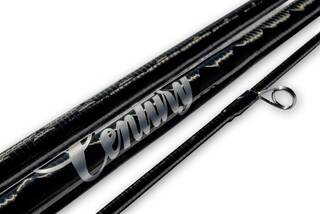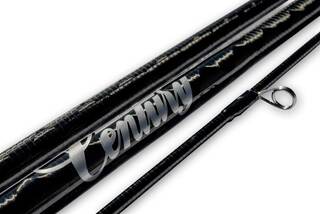Century
Vertical Jig BLANKS
Couldn't load pickup availability
The Century VJ series feature Century's best materials, full carbon and graphene design along with anti-twist technology, Textreme® outer armor and autoclave processing. Fitted with titanium guides. These rods are meant to out perform, and outlast anything on the market while maintaining an incredible durability and light weight.
Fast Action
As of August 2025, Blank Prices include $20 Tariff Fee. Discounts do not apply to fee.
Materials
Materials
•Autoclave Technology (Used by F-1 and aerospace industry to produce a completely void-free and resin lean composite.
Producing the longest lasting and most sensitive rods on the market
•Blended premium carbon fiber construction, for the best
possible performance, strength, and durability
•Rod actions that work well with aerodynamic and
un-aerodynamic baits and lures both
•EVA Shrink tube grips (Thin, light, non-slip) Anti Twist Technology (ATT) (Keeps rod blank straight and true even under torsional loads of casting and fish fighting)
•Rods built with guides on spine (Guides wrapped on
the proper axis of the rod blank to achieve optimum
performance and rod life)
•SurfMachine Elite and Weapon rods are manufactured with Fuji torzite titanium components and all other rods are manufactured with quality titanium components for corrosion resistance and weight reduction.
•Century rods are built with one coat of slow cure epoxy for
reduced weight and delamination.
•Proudly hand made in the USA (blanks from Great Britain)
Shipping & Returns
Shipping & Returns
Dimensions
Dimensions
Care Instructions
Care Instructions
Your assurance of quality and performance!
We design and build rods to perform in the most demanding and exacting of circumstances. If you follow our rod care recommendations, your rod should give you years of fishing enjoyment.
• Your rod is a precision instrument designed to cast exceptional distances and play out record fish. Carbon fiber fishing rods are not indestructible though and must be treated with care and respect.
• Carbon rods and poles are very efficient conductors of electricity. To avoid any danger of electrocution, take GREAT care when using rods near overhead electrical wires, power stations, or in electrical storms.
• Rods are designed to bend over their WHOLE length and full performance curve. If you put a very tight bend or arc in the tip (such as "high sticking" or to manually 'test the action' ) you may over-strain joints and damage the carbon fiber structure and cause rod failure.
• When you pick up your rod, always hold it at the handle, NEVER the tip.
• Our rod joints are precision ground to an interference fit. Before putting your rod together, always check joints are clean and free from dirt, grit, and sand, otherwise, you may have difficulty taking the rod apart. Keeping the joint clean will help stop excessive joint wear. Protect the joint with an occasional light coating of PTFE lubricant.
• Always check the joint is properly engaged before using your rod. Casting or fishing with limited or incorrect joint engagement is a common way to damage a rod.
• When separating rod joints, grip with each hand as close as possible to the joint and use a simultaneous twist and pull action. NEVER twist joints apart by holding further up the butt and tip as this can torque load the part and damage the rod wall.
• Your rod should always be cast with the recommended casting weight and not dry cast. Test casting without the correct loading can result in stress that can damage the rod and cause rod failure.
• When threading line through the rings, NEVER pull the line down near the rod against the reel drag. This can column load the rod and create multiple' bends in the tip which may exceed the design parameters of the rod and cause it to fail. Instead, ALWAYS pull the line from the tip guide well away from the rod.
• Before casting, check that the line is not wrapped around the tip, especially if fishing at night or using multi-hook rigs in windy conditions. Make sure your leader knots are smooth and that you do not have a swivel between any guides before casting. These are some of the commonest causes of rod breakages.
• Take care when casting to avoid injury to other people and yourself. Weights can travel at very high speeds and can cause serious injury unless the caster or angler takes proper care.
• Heavy rough marks need appropriate lines. When fishing heavy seas, stop and clear build-ups of weed or detritus as this can put severe pressure on the tip.
• When a line is snagged, NEVER pull the rod back to free the line. Always put the rod down and HAND LINE, taking care to protect your hands from being cut by the line.
• If you use a braid or PE line, remember their low stretch characteristics transfer the force exerted directly to your rod, so take extra care if your line is snagged.
• DO NOT swing large fish to hand by bringing the rod past the vertical. This creates a column loading on the tip for which the rod is not designed. It may also damage the tip ring.
• Do not use your rod to lift large fish up piers or cliffs. Use a net or hand line taking care to protect your hands.
• Be careful you do not knock or drop your rod on rocks or hard surfaces. Be careful when casting or fishing that the weight or fly does not hit the rod. Impact damage can cause the carbon fiber to fail and a rod to break. Century uses tough epoxy resin systems and autoclave technology for maximum strength in its fishing rods, but all carbon fibers are vulnerable to impact damage.
• Take care around car doors and boots (trunks.) We cannot design the sort of performance you expect from a Century rod and make it immune to the crushing force of a car door!
• Keep your rod in good condition and look after its appearance by keeping it clean and wiping it down after use with warm soapy water. Allow it to dry completely before putting it away in its bag or case. Do NOT store rods in wet bags; this will cause damage to varnish and fittings. Do NOT use solvents, acetone, or petrol-based substances to clean your rod as this may damage the finish and fittings.
• Do NOT allow baits, particles, or colorants to build upon the rod as they can become extremely difficult to remove, especially when exposed to strong sunlight where they can bake onto the rod. This will not damage the rod but will spoil its appearance.



